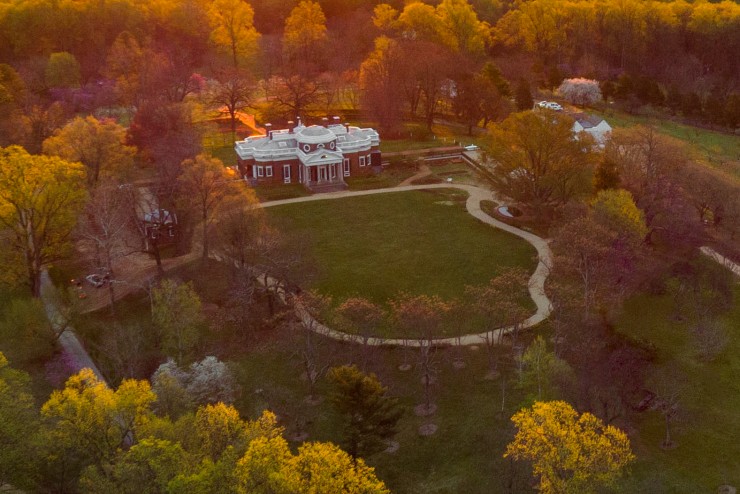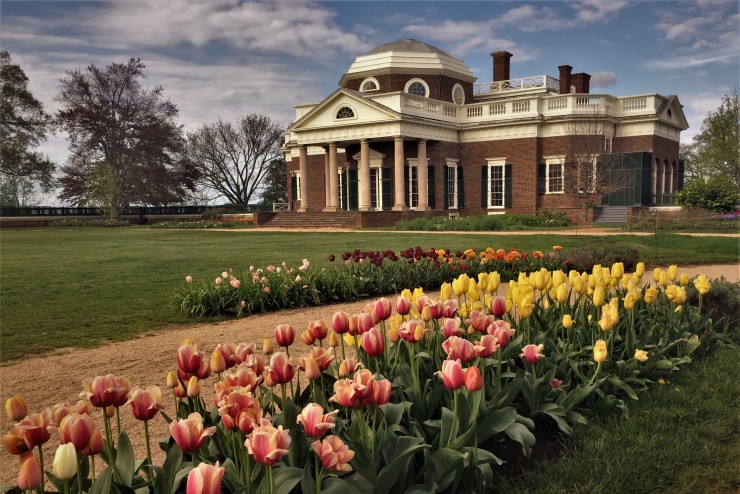I find that the limited number of our flower beds will too much restrain the variety of flowers in which we might wish to indulge, and therefore I have resumed an idea . . . of a winding walk . . .with a narrow border of flowers on each side. This would give us abundant room for a great variety.
— Thomas Jefferson to Anne Cary Randolph, June 7, 1807
Jefferson's winding walk and the accompanying flower border were laid out in the spring of 1808. A sketch of his design also included four large oval-shaped areas that were to be planted with flowering shrubs; however, it is not known if these were ever installed. By 1812, Jefferson needed a more systematic organization of the border and so divided the beds into ten-foot sections, each compartment numbered and planted with a different flower.
The Winding Flower Border

Detail from an 1807 sketch by Jefferson of the garden around the main house on the back of a letter to his granddaughter Anne Cary Randolph (Bankhead). Image: Coolidge Collection of Thomas Jefferson Manuscripts at the Massachusetts Historical Society.

The Winding Flower Border and Oval Beds were restored by The Garden Club of Virginia between 1939 and 1941.

Tulips dominate the Winding Flower Walk in April and early May. (Photo: Bill Bergen)

The walk's winding lines and the differing habits and colors of the flowers offer varying views to the visitors.
The winding walk and border is not a traditional "garden," which usually suggests a room outside, an enclosed retreat. Jefferson's flower beds and borders are exposed to the elements, open to the central Virginia landscape, intimately balanced with what he called "the workhouse of nature . . . clouds, hail, rain, thunder, all fabricated at our feet." The winding, relaxed lines of the walkway reflect Jefferson's interest in the latest, informal style of landscape design, which he had admired during his visit to English gardens in 1786. British garden architects attempted to imitate the picturesque scenes of eighteenth-century landscape painters by removing the rigid, formal designs of an earlier era.
The flower gardens were primarily cared for by enslaved gardener Wormley Hughes who carried out Jefferson's annual planting plan. Jefferson's granddaughter, Ellen Randolph Coolidge, recalled the heyday of flower gardening at Monticello:
I remember well when he first returned to Monticello, how immediately he began to prepare new beds for his flowers. He had these beds laid off on the lawn, under the windows, and many a time I have run after him when he went out to direct the work, accompanied by one of his gardeners, generally Wormley, armed with spade and hoe, whilst he himself carried the measuring-line. I was too young to aid him, but my sister was his active and useful assistant . . .The roots arrived, labelled each with a fancy name. There was Marcus Aurelius, and the King of the Gold Mine, the Roman Empress, and the Queen of the Amazons, Psyche, and God of Love, etc., etc., etc. Eagerly and with childish delight, I studied this brilliant nomenclature, and wondered what strange and surprisingly beautiful creations I should see rising from the ground. Then, when spring returned, how eagerly we watched the first appearance of the shoots above ground. What joy it was for one of us to discover the tender green breaking through the mould, and to run to grandpapa to announce, that we really believed Marcus Aurelius was coming up, or the Queen of the Amazons was above ground. Then when the flowers were in bloom, and we were in ecstasies over the rich purple and crimson, or pure white, or delicate lilac, or pale yellow of the blossoms, how he would sympathize in our admiration, or discuss with my mother and elder sister new groupings and combinations and contrasts. Oh, these were happy moments for us and for him!
FURTHER SOURCES
- Betts, Edwin M., Hazlehurst Bolton Perkins, and Peter J. Hatch. Thomas Jefferson's Flower Garden at Monticello. 3rd ed. Charlottesville: Thomas Jefferson Memorial Foundation, 1986.
- Betts, Edwin M., ed. Thomas Jefferson's Garden Book, 1766-1824: With Relevant Extracts from His Other Writings. Philadelphia: The American Philosophical Society, 1944. Reprint, Charlottesville: Thomas Jefferson Memorial Foundation, 1999. Manuscript and transcription available online at the Coolidge Collection of Thomas Jefferson Manuscripts, Massachusetts Historical Society.
- Hatch, Peter J. "The Gardens at Monticello." In Thomas Jefferson's Monticello. Charlottesville: Thomas Jefferson Foundation, 2002. See pp. 113-51.
- Look for further sources in the Thomas Jefferson Portal.
